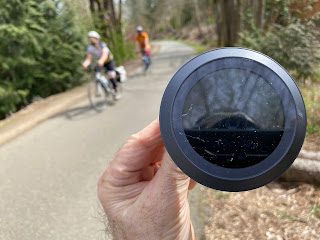Is Outside Air COVID Safe? Are Masks Needed Outdoors?
When I visit parks in Seattle and the region, bike along the Burke Gilman Trail, cross-country ski at WA snowparks, or go hiking in the Cascades, I note that many people are wearing masks outdoors to avoid COVID-19. A lot of people.
Some folks are clearly afraid and fearful of COVID exposure outdoors. For example, I often see individuals making a point to avoid unmasked bikers or joggers on the Burke-Gilman trail...moving 5-10 feet off the trail and sometimes turning away. Occasionally it gets tense, as when one local scientist (not me) was angrily called a "Republican" when he was walking in a park without a mask.
The fear of outdoor spread even hit the management of Seattle Parks last year, when several parks and their parking lots were closed because of COVID fears.
It is time to bring science to this issue and to relieve the worries of many who wish to enjoy outdoor recreation.
In this blog, I will tell you about measurements of carbon dioxide (CO2) I took around Seattle this weekend, measurements that suggest little threat of COVID transmission outdoors. I will also review some of the latest scientific literature, which again does not indicate a significant threat of COVID transmission in the outside air.
The message of this information is obvious: wearing masks outdoors does not appear to be necessary.
My Field Experiment Around Seattle
In my experiment, I used a sensitive CO2 sensor that makes use of proven measurement technology (see below). Human breathing puts out a lot of CO2, roughly 4 percent by volume or roughly 40,000 parts per million (ppm). The background level of CO2 in the free atmosphere is currently approximately 415 ppm.... a concentration much, much less than coming out of our mouths.
Thus, CO2 can act as a tracer of the air coming out of our respiratory systems, something mosquitoes know all about since they use the plume of CO2 we exhale to find us. By measuring CO2 levels, it is possible to determine the relative concentration of air coming from humans and the degree of dilution by the surrounding air.
There have been a number of peer-reviewed scientific papers that have shown that CO2 concentrations are a potent tool for evaluating the potential for disease spread by viruses and other agents, with higher concentrations of CO2 associated with more transmission of disease (some examples of relevant scientific papers found here and here).
Most of these papers use CO2 to measure the potential for transmission in indoor spaces, so why not take it one step further and evaluate potential disease transmission in the outside environment? That is what I did around Seattle on Saturday, a very nice day (high around 63F) with lots of people in the parks and outdoor locations.
My CO2 unit reported about 400-405 ppm away from roads and people, and this value represents the background level of carbon dioxide.
The Burke-Gilman Trail
My first stop was the crowded Burke Gilman trail, with folks walking, running, and whizzing by continuously. There was no increase in CO2 concentrations compared to the background at any time (around 400). Clearly, the diffusion/dispersion/dilution of CO2 by outside environmental air was very large. And the same would be true of any COVID virus breathed out by anyone on the trail.
Magnuson Park
I then traveled to Magnuson Park, one of the most popular parks in Seattle. First, I walked about a half-mile, back and forth, on a crowded path. No increase in CO2 values above background (still around 400 ppm).
Then I decided to really push things and walked around crowded picnic shelters, some with as many as 15-20 peoples without masks. (I suspect they thought I was being a bit odd as I circled around the groups, but this was for science!) I could find no enhancement of CO2 above the background levels....natural movement of air diffused their CO2 emissions completely. I did find a weak signal downstream of a raging barbecue fire...but even that was muted (about a 10 ppm increase 40 feet downwind).
So the bottom line so far: natural ventilation and mixing in the outside air was effective in diffusing the CO2 emitted by people in an outside park environment, even when there was a high density of people. And if CO2 enhancement by all the people was undetectable, the same would be true of COVID-19 virus emission by any infected individuals. Parks appear to be entirely safe locations and masks are not necessary.
University Village Shopping Center: Outside and Inside
Next, I went to the University Village shopping center. There is a nice little urban park adjacent to the Apple Store. It was packed with people enjoying the nice weather. If there was going to be a place where human CO2 would be evident, this would be it, particularly with nearby structures lessening the wind flow.
- Qian et al., 2020: Examined 1245 confirmed cases in 120 cities in China and identified only a single outbreak in an outdoor environment, which involved two cases.
- Nishiura et al., 2020: Transmission of COVID-19 in a closed environment was 18.7 times greater compared to an open-air environment (95% confidence interval). (they could not exclude the possibility that the few "outdoor" transmission might have occurred by undocumented indoor transmission)
- Bulfone et al., 2021: A review of all the literature on outdoor transmission. They found only five studies, two of which are above. They noted the poor quality and inconsistent approaches of most of the studies so far.
Public Radio Station KNKX and Cancel Culture: What Happens When a Public Radio Station Rejects Viewpoint Diversity and Goes Political.









Comments
Post a Comment